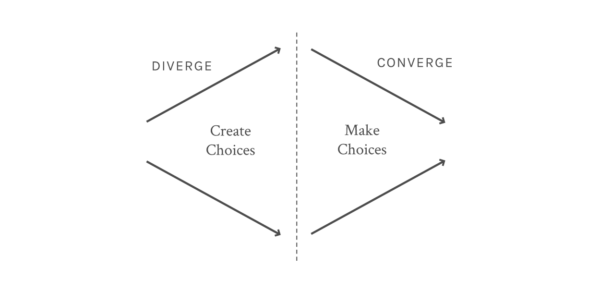Change By Design • Tim Brown • 2009
On the Characteristics of Design Thinking
In Short
The range of capabilities that make up design thinking include human-centeredness, divergent/convergent thinking, experimentation, and storytelling.
In Depth
The ideas in Brown’s book have had time to be absorbed into the design industry, so many of his points may seem obvious to many designers. But it is useful to review the key pillars upon which he set his characterization of design thinking, since IDEO has been an influential player in the promotion of the term.
The following summarizes some of the key capabilities of designers that Brown puts forward as qualities of design thinking.
Putting People First
The designer’s ability to seek insight from actual people and circumstances:
Insight is one of the key sources of design thinking, and it does not usually come from reams of quantitative data that measure exactly what we already have and tell us what we already know. A better starting point is to go out into the world and observe the actual experiences of computers, skateboarders, and registered nurses as they improvise their way through their daily lives. (pp.40-41)
The designer’s ability to recognize another’s needs through empathy:
Empathy is the mental habit that moves us beyond thinking of people as laboratory rats or standard deviations. If we are to “borrow” the lives of other people to inspire new ideas, we need to begin by recognizing that their seemingly inexplicable behaviors represent different strategies for coping with the confusing, complex, and contradictory world in which they live. (p.49)
Embracing Complexity
The designer’s ability to work with complexity as inspiration, rather than obstacle:
Integrative thinkers know how to widen the scope of issues salient to the problem. They resist the “either/or” in favor of the “both/and” and see nonlinear and multidirectional relationships as a source of inspiration, not contradiction... They allow complexity to exist, at least as they search for solutions, because complexity is the most reliable source of creative opportunities. (pp.85-86)
The designer’s ability to balance expansive, divergent thinking, with solution-focused, convergent thinking:
The process of the design thinking… looks like a rhythmic exchange between the divergent and convergent phases, with each subsequent iteration less broad and more detailed than the previous ones. In the divergent phase, new options emerge. In the convergent phase it is just the reverse: now it's time to eliminate options and make choices. (p.68)

Building To Think
The designer’s ability to jump into prototyping to learn:
Since openness to experimentation is the lifeblood of any creative organization, prototyping—the willingness to go ahead and try something by building—is the best evidence of experimentation. (p.88)
The goal of prototyping is not to create a working model. It is to give form to an idea to learn about its strengths and weaknesses and to identify new directions for the next generation of more detailed, more refined prototypes. (p.91)
The designer’s ability to discover and accept constraints:
To an artist in pursuit of beauty or a scientist in search of truth, the bounds of the project may appear as unwelcome constraints. But the mark of a designer, as the legendary Charles Eames said often, is a willing embrace constraints. (p.17)
Storytelling
The designer’s ability to make an idea come to life for others:
Mostly, we rely on stories to put our ideas into context and give them meaning. It should be no surprise, then, that the human capacity for storytelling plays an important role in the intrinsically human-centered approach to problem solving, design thinking. (p.132)